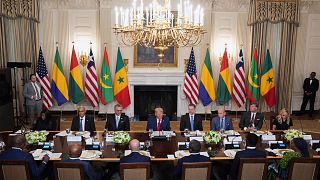nile river
170 metres high and almost 2 kilometres long, this Great Ethiopian Renaissance Dam will be the largest hydroelectric installation in Africa.
The project, which began construction ten years ago, is located on the Blue Nile, a river that joins the White Nile in Khartoum and provides 60% of the Nile's flow.
Ethiopia is about to complete this flagship project for its economic development. However, the country is unable to resolve the discord with its neighbours: Egypt and Sudan, who fear its impact on their water supply.
For several years, negotiations have been underway to find common ground between the three countries with the African Union coming on board to oversee talks -- the latest held this week in Kinshasa once again reaching an impasse.
William Davison, a senior analyst at the International Crisis Group, attempts to give some insight into the ongoing situation.
"Among the main sticking points is how the dam will be managed during different periods of drought, which comes down to how much water Ethiopia would be willing to release from the dam reservoir.
"There is also the issue of dispute resolution. If there is a disagreement, Sudan and Egypt want international arbitration in the final phase of the dispute resolution process. Ethiopia is not prepared to accept this, it believes that such an arrangement is inappropriate," he explains.
The Nile provides Egypt with most of its irrigation for agriculture and drinking water.
Sudan is concerned that its own dams could be damaged by the new structure.
The issue has intensified as Ethiopia began filling the reservoir last summer during the rainy season and confirmed on Wednesday its plan to continue this year -- as confirmed by Seleshi Bekele, Minister of Water, Irrigation and Energy of Ethiopia.
"In the second year of filling, it is very clear it has nothing to do with anything. As construction progresses, filling takes place."
Ethiopia is experiencing rapid economic growth but half of its population does not have access to electricity. Hence the importance of this dam project at a cost of an estimated 4 billion euros -- entirely financed by Adis Ababa.
The announced capacity of the dam is over 6,000 megawatts (for a reservoir of 74 billion cubic metres of water) to be filled completely in stages over at least 4 years.
The first two turbines are to be commissioned within a year.
Egypt's top diplomat told the media on Tuesday that -- along with Sudan, it would take the dispute to international organizations, including the United Nations Security Council.
Ethiopia’s counterpart expressed the willingness to "reach a win-win outcome that would not foreclose its current and future legitimate rights over the utilization of the Nile."
African Union head and Congolese President Félix Tshisékedi said "the Nile River must remain a fertile source of life and shared prosperity'' -- as tensions over the Nile's waters continue to to mount between Ethiopia, Sudan and Egypt.












01:13
China and Ethiopia reaffirm alliance at meeting on sidelies of BRICS summit
01:05
Ethiopia's mega-dam on the Nile is "now complete", Prime Minister says
01:49
Sudanese refugees in Chad face deepening humanitarian crisis
Go to video
UN warns of escalating humanitarian catastrophe in Sudan amid ongoing conflict
Go to video
China, Egypt FMs discuss Middle East escalation in phone call
01:41
UN warns of looming famine in Sudan, Gaza and 3 other global hunger hotspots